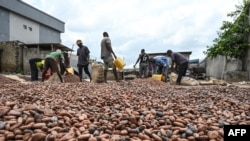The world's top cocoa producer is at the tail end of its rainy season, and entering a dry season that runs officially from mid-November to March. Rainfall is low and sporadic during this period.
The dry season also brings Harmattan winds that blow south from the Sahara between December and March. The Harmattan can damage crops when too strong.
Several farmers said they expected the main crop to peak with abundant harvests in December and January.
But they noted that early Harmattan winds could hinder the development of small pods that should be ready for harvest in February and March, leading to a shortage of beans.
"For now everything is fine. We have a lot of harvesting but we are wondering when the Harmattan will arrive and how it will behave," said Claude Amani, who farms near the central region of Yamoussoukro, where 24.7 millimeters (mm) of rain fell last week, 16.3 mm above the five-year average.
Similar conditions were reported from the center-western region of Daloa and the central region of Bongouanou.
Rainfall was also above average in the southern regions of Agboville and Divo, where farmers said they were cutting plenty of cocoa pods from trees as tree yields were increasing.
They added that the weather was ideal for drying beans.
"We are off to a good start for many harvests until next year," said Emmanuel Yavo, who farms near Agboville, where 24 mm of rain fell last week, 3.9 mm above average.
Rainfall was below average in the western region of Soubre and in the eastern region of Abengourou.
Average weekly temperatures ranged between 27.6 and 29.2 degrees Celsius.

Forum